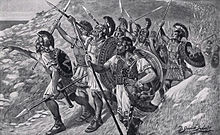This article is an orphan, as no other articles link to it. Please introduce links to this page from related articles; try the Find link tool for suggestions. (August 2024) |
The Southern Colchis War or the War of the Ten Thousand was a conflict that took place in Southern Colchis (near Trabzon) between elite and heavily armored Greek hoplites and the Colchian people. Since Xenophon did not name this battle in his work Anabasis, the conflict is referred to by the region where it took place.
| Southern Colchis War | |||||||
|---|---|---|---|---|---|---|---|
 Depiction by Hermann Wilhelm Vogel in the 19th century | |||||||
| |||||||
| Belligerents | |||||||
| Greeks, elite and heavily armored Greek hoplites |
| ||||||
| Commanders and leaders | |||||||
| Xenophon | Unknown | ||||||
| Units involved | |||||||
| 10,000 | Unknown | ||||||
| Casualties and losses | |||||||
| Unknown, but few | Unknown, but many | ||||||

Background
editBetween 404 and 359 BCE, the Achaemenid Empire experienced a series of internal power struggles, weakening its control over peripheral regions. Cyrus the Younger, the satrap of Cappadocia and Lydia, sought to seize the Achaemenid throne and hired elite and heavily armored Greek hoplites to strengthen his forces. The army, led by Xenophon, marched to Babylon to support Cyrus. However, Cyrus was killed in Babylon, and his army disbanded. As the Greeks were returning to Greece, they decided to pass through the Bayburt Plain to reach Trabzon. The Greek forces first encountered the Macrones. A Greek soldier claimed to understand the Macrones' language and communicated with them. After negotiations, both sides exchanged spears as a sign of mutual trust. The Macrones assisted the Greeks by opening up the route and guiding them through the region. In this way, the Greeks arrived at the border of the Colchian territory. The 10,000-strong Greek army needed supplies, so they attacked the Colchians. The locals took refuge in large fortresses, abandoning the other areas. Xenophon, who was skilled in military matters, wrote in his records that the people living in the South Caucasus were good soldiers.
The War
editThe Colchians
editArchaeological findings clearly indicate the weapons used by Colchian soldiers. The Greek historian Herodotus wrote that the Colchians, Mossynoecians, and Tibarenes were part of the Persian army that the Greeks fought against. The Colchian lands, divided into tribes, did not have a strong and organized military system. As a result, the Colchians armed themselves and used equipment and weapons that could be easily obtained at low cost. A typical Colchian warrior had a wooden leather shield, a helmet made of leather or wood, armor made of leather or linen, a small weapon, a short iron axe, and a Colchian axe made of bronze or iron. Only the nobles had high-quality equipment and iron weapons, and they were few in number compared to the common folk. It is also recorded that there were cavalrymen among the Colchians. These cavalrymen were likely nobles.
The Greeks
editThe Greeks possessed one of the most powerful armies of their time. Greek phalanxes, consisting of hoplites arranged in about 15 rows, were heavily armed with swords, spears, shields, helmets, barges, and armor.
The Battle
editThe Colchian leaders were aware of the route the Greeks were taking through Colchis. Therefore, as Xenophon approached Colchis, he encountered military forces. The Colchian forces had positioned themselves on a strategic hill along the route to Trabzon, likely in the Pontic Mountains. Upon noticing the Colchian forces, the Greeks adjusted their strategy, suggesting the strength of the Colchian forces.
The Greeks initiated the conflict. Divided into small detachments, the Greek forces launched a coordinated attack on the hill. The Colchian forces were not divided and remained in a phalanx formation; an archer infantry unit was stationed behind a cavalry detachment. With the first Greek assault, the Colchian forces quickly split in two. In this way, half of the forces regrouped on the left and the other half on the right. This maneuver was meant to open the central phalanx and attack from two separate flanks, while also preventing the forces from being surrounded. However, the Greeks overcame the resistance and forced the Colchians to retreat by forming a wall of shields and spears. The Colchians were unable to hold their position. The frontal assault of the hoplites destroyed the Colchian phalanx, and the units behind them did not engage in combat, instead taking refuge in a nearby fortress. Having won the conflict, the Greeks pillaged the surrounding villages for 30 days. The Greeks also consumed mad honey from these villages, which led to poisoning. Xenophon noted that those who consumed small amounts of the honey became drunk, while those who consumed a lot went mad. It is believed that the Colchians deliberately left this honey out, and that mad honey was the first biological weapon used in history to incapacitate enemies.[1]
References
edit- ^ "Deli bal hem ilaç hem zehir". hurriyet.com.tr. Archived from the original on 16 October 2014. Retrieved 9 October 2014.
- Xenophon. "Anabasis" Chapter V. VI. VII
- C. Gamkrelidze "War and Armament in Iberia in Colchis" (Bakur Sulakauri Publishing House, 2010)
- ნ. Berulava "Development of Colchian armament in the Adreantic and Hellenistic eras"